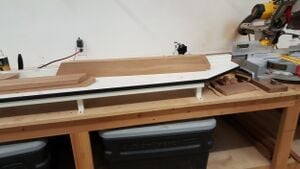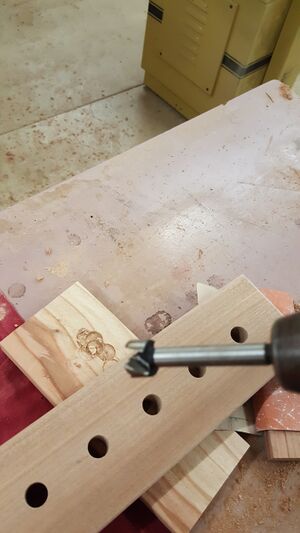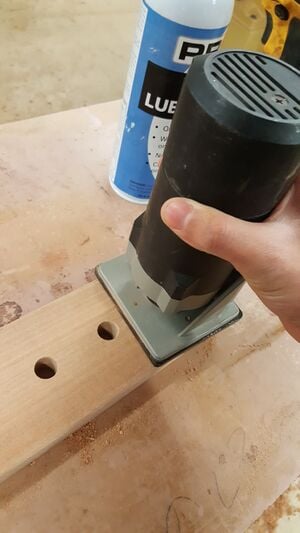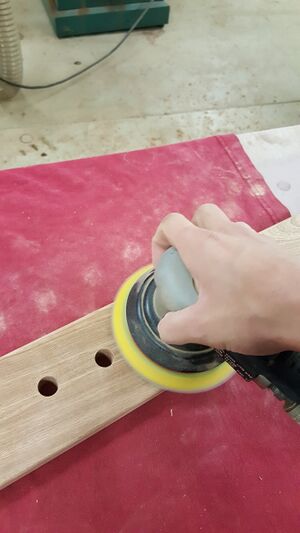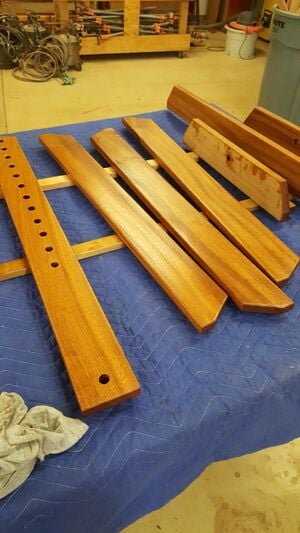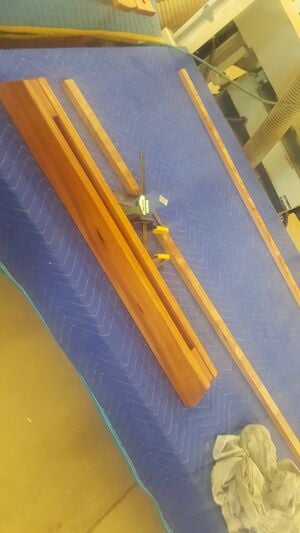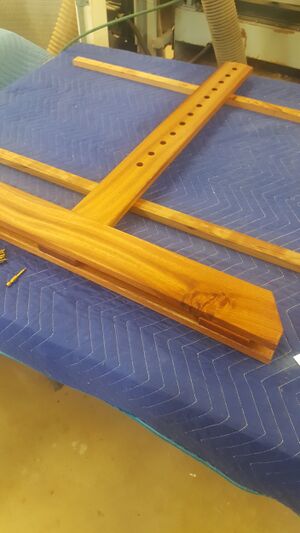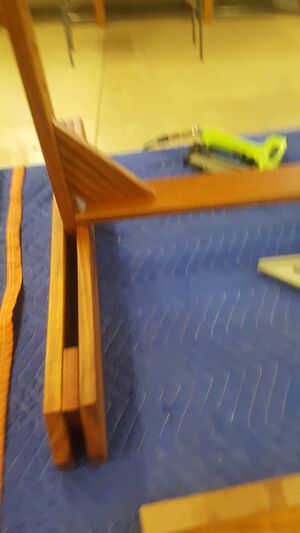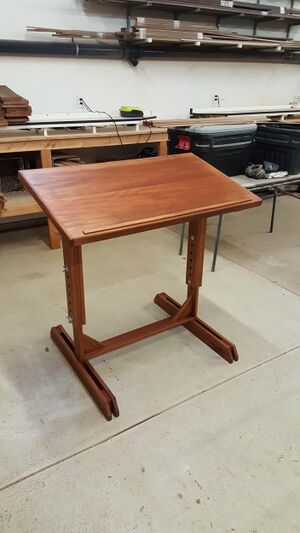
Abstract[edit | edit source]
The Stand Up Fidget Desk is a project built by students from the Engineering 215 design course from the Environmental Resources Engineering major at Cal Poly Humboldt. The project entails designing a stand up fidget desk that will effectively help middle schoolers with the learning disability ADHD stay focused in the classroom. The desk will be utilized by approximately 10 students during a 7-hour school day, 5 days a week. The client for this project is Celia Boomer teacher at Zane Middle School located in Eureka California. The desk will be adjustable so that it accommodates students of different heights. The team Hardworking Procrastinators will strategically place different types of fidgeting tools on the desk to achieve the primary goal of the project, helping students stay focused.
-
Fig 1: This is our final design of the Fidget Desk
Background[edit | edit source]
The stand up fidget desk created by team Hardworking Procrastinators in spring 2017 is a learning device that will be used in Celia Boomer's classroom at Zane Middle School. The Stand up fidget desk will aid middle schoolers with the learning disability ADHD, by providing a resource to help them stay focused in the classroom. Kids with ADHD are best known for not being able to sit still, especially in a place like a classroom where it is mandatory to do so. To decide what fidgeting components were implemented on the desk, team Hardworking Procrastinators consisting of Kaden Law, Sarah Parr, Gilberto Sandoval, and Madison Whitlow-Hewett did extensive research on the topic of ADHD and how fidgeting helps kinesthetic learners such as kids with ADHD increase their focus in the classroom. Celia Boomer, the client has already purchased a handful of fidget cubes, but the stand up fidget desk will do one better.
Problem Statement and Criteria[edit | edit source]
Problem: Students at Zane Middle School get distracted in class.
Objective: To create a stand up desk that featured silent fidget components to help students with ADHD stay focused during class without disrupting other students.
Criteria Definition
The following criteria played a pivotal role in the decision process:
Fidgetability: Mechanisms that allow students to fidget silently while maintaining focus must be efficiently incorporated into the desk. The desk must contain multiple fidgeting apparatus that engage the students hands and feet.
Aesthetics: The desk must be appealing to both faculty and students while retaining a similar aesthetic to the other desks so that it matches the overall design of the classroom. The desk should not stand out and look as if it could fit in a professional workplace. All objects incorporated into the desk must look as if they belong there and function with ease.
Cost: This is the amount of money, time, and effort that will be spent on this project. The financial cost cannot exceed the budget of 400 USD. Time and effort will vary by person.
Safety: All elements of the desk must be intact and must not pose any hazards for the students. The desk's corners must be rounded so that the potential risks involved with sharp corners are minimized. The desk must remain balanced when students exert force on a certain side to prevent tipping of the desk and possible injuries. The fidget tools incorporated into the desk must not come off with ease as kids can put them in their mouth which then creates a choking hazard.
Durability: This is the overall abuse that this desk will be able to endure. The desk must retain its structural integrity while accommodating over ten students per day over the next school year. The fidgeting tools as well as the mechanism that will enable the desk to be easily adjusted to different heights should be built to withstand constant use and allow for easy repairs if needed.
| Criteria | Constraints | Weighted rank (#) |
|---|---|---|
| Fidgetablility | More than 2 silent fidgeting components | 10 |
| Durability | Able to accommodate more than 10 students daily | 8 |
| Safety | Must maintain structural integrity with consistent use | 6 |
| Aesthetics | Similar in style to desks already utilized in the classroom | 5 |
| Cost | Less than $400 | 3 |
Description of final project[edit | edit source]
Costs[edit | edit source]
| Quantity | Material | Source | Cost ($) | Total ($) |
|---|---|---|---|---|
| lots | Wood | Wood working shop | 0.00 | 0.00 |
| 2 | Play-station controllers | personal | 0.00 | 0.00 |
| 1 | CD spinner | personal | 0.00 | 0.00 |
| 2 | Fidget Spinners | Amazon | 9.99 | 19.98 |
| 6 | 3" Carriage bolts | Home Depot | 1.25 | 7.50 |
| 6 | 1/2" Washers | Home Depot | 0.45 | 4.50 |
| 6 | 1/2" Wing Nuts | Home Depot | 1.50 | 15.00 |
| 6 | Resistance band | Amazon | 11.69 | 11.69 |
| 1 | Bottle of Feed-N-Wax | Ace Hardware | 10.99 | 10.99 |
| Bag | Small wooden circles | Scrap | 1.50 | 1.50 |
| 1 | Record | Scrap | 0.50 | 0.50 |
| 2 | Dowel 36" 1/8" | Michael's | 0.39 | 0.78 |
| 3 | Fimo Clay | Michael's | 1.99 | 5.97 |
| 1 | White lithium grease | Ace Hardware | 2.99 | 2.99 |
| lots | Miscellaneous nuts and wing nuts | Ace Hardware | 9.53 | 9.53 |
| 2 | Super glue | Ace Hardware | 3.99 | 6.98 |
| 1 | Metallic acrylic paint | Michael's | 1.49 | 1.49 |
| 1 | Metallic spray paint | Ace | 6.99 | 6.99 |
| 1 | Nail polish; clear | Walmart | 2.97 | 2.97 |
| 1 | Spray paint | Walmart | 0.96 | 0.96 |
| 1 | Dowel 1/2x36" | Pierson building center | 1.79 | 1.79 |
| 1 | 1-1/8 wainscoat | Pierson building center | 8.49 | 8.49 |
| 1 | Sandpaper | Pierson building center | 0.49 | 0.49 |
| Total Cost | 121.09 | |||
Testing Results[edit | edit source]
The Desk:
After testing the adjustability of the desk, we discovered that it takes two people to raise and lower the height. We would have liked it to have been easier to adjust, but this is what we have to work with. You need one person to lift and hold the desk and a second person to move the bolts to the new hole. The pencil catcher works just fine and so does moving the angle of the desk surface.
The Fidget Toys:
The toys work perfectly, they are fun to play with and are not too distracting sound-wise. They are not too colorful but do match the school colors and the theme of the classroom. The foot swing and abacus was a great success. There is enough space in the center of the desk to write on as well.
-
Fig 2: Prototyping the fidget spinners on wood to test the sound
How to build[edit | edit source]
Fidget Components[edit | edit source]
Maintenance[edit | edit source]
This desk is very durable and should require hardly any maintenance. The wood is strong and the design is structurally sound. That being said, all projects have small flaws. This tells you what to look out for.
Schedule[edit | edit source]
This is when to maintain what.
- Monthly
- Check to see if the fidget toys wear down and need to be replaced
- Grease the metal wheels and fidget spinners to reduce sound
- Yearly
- Make sure the structural integrity of the desk is sound and that the wood is holding up
- Check the tension on the foot swing
Troubleshooting[edit | edit source]
| Problem | Suggestion |
|---|---|
| Spinning fidget toys become to loud over time | May need WD-40 |
Discussion and next steps[edit | edit source]
The Stand Up Fidget Desk is utilized by approximately 10 students during a 7-hour school day, 5 days a week. The desk is primarily in use during the school year from September to June, with the exception of vacations. The desk is function-able as a typical scholarly desk with the added benefit of having silent fidgeting components for both hand and foot use. The desk has the capability of being adjusted to different height levels to accommodate the user. The fidgeting components of the desk are used to focus the user's attention during class without causing distractions to other students. The production of the desk was done using a woodworking shop, and with donated free wood. Many hours were spent building this desk. The first stage was to build a sturdy, adjustable desk which will be done in the woodworking shop. The second stage is to build the top of the desk with the fidget toys. This was not free (look at costs) and is fine-tuned and professional looking. The decisions for what to put on the desk took the team a while, with a lot of brainstorming and deliberation. The final decisions for the desk are as follows; the top of the desk will contain a plethora of things, including 2 fidget spinners, a handmade abacus, a long bolt containing some nuts and wingnuts that spin, and some buttons and joysticks taken from a play station 2 controller. The underside of the desk contains a bungee foot swing. The next steps to be taken in this project will progress when the addition of new toys will need to be added due to the wear and tear of the fidget toys as they are used as intended.
Suggestions for future changes[edit | edit source]
This project is designed to maximize focus for students with ADHD. So as the fidget industry develops more toys to help students with there learning disabilities, more things can be added to the desk. Some simple additions that can be made are giant rubber bands on the sides of the desk for students to bounce there legs off of. Another addition, if necessary, can be a stool.


